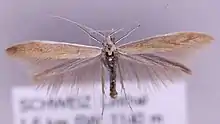Coleophora niveicostella
Coleophora niveicostella is a moth of the family Coleophoridae and was first described by Philipp Christoph Zeller in 1839. It is found from Sweden and Latvia to Spain, Italy and Greece and from Great Britain to Romania.
| Coleophora niveicostella | |
|---|---|
 | |
| Scientific classification | |
| Domain: | Eukaryota |
| Kingdom: | Animalia |
| Phylum: | Arthropoda |
| Class: | Insecta |
| Order: | Lepidoptera |
| Family: | Coleophoridae |
| Genus: | Coleophora |
| Species: | C. niveicostella |
| Binomial name | |
| Coleophora niveicostella | |
| Synonyms | |
| |
Description
The wingspan is 11–13 millimetres (0.43–0.51 in). Adults are on wing in July.[2]
The larvae feed on Thymus praecox, Thymus pulegioides and Thymus serpyllum. They create a slender, brownish black, bivalved case of 7–8 millimetres (0.28–0.31 in). The oral half is tubular, while the rear part strongly laterally compressed. The mouth angle is about 30°. The case looks like a sheath case, but is in fact a composite leaf case. The larva cuts off mined leaves, after having removed the complete leaf margin: what is left is an upper and a lower epidermis, connected by the stub of the petiole. Leaves treated in this way are placed in front of the old case.[3] Full-grown larvae can be found in mid June.
References
- "Coleophora niveicostella Zeller, 1839". Fauna Europaea. Retrieved 9 December 2019.
- "37.043 [B&F: 0548] Coleophora niveicostella Zeller, 1839". Hants Moths. Retrieved 9 December 2019.
- "Coleophora niveicostella". Plant Parasites of Europe. Retrieved 10 August 2020.